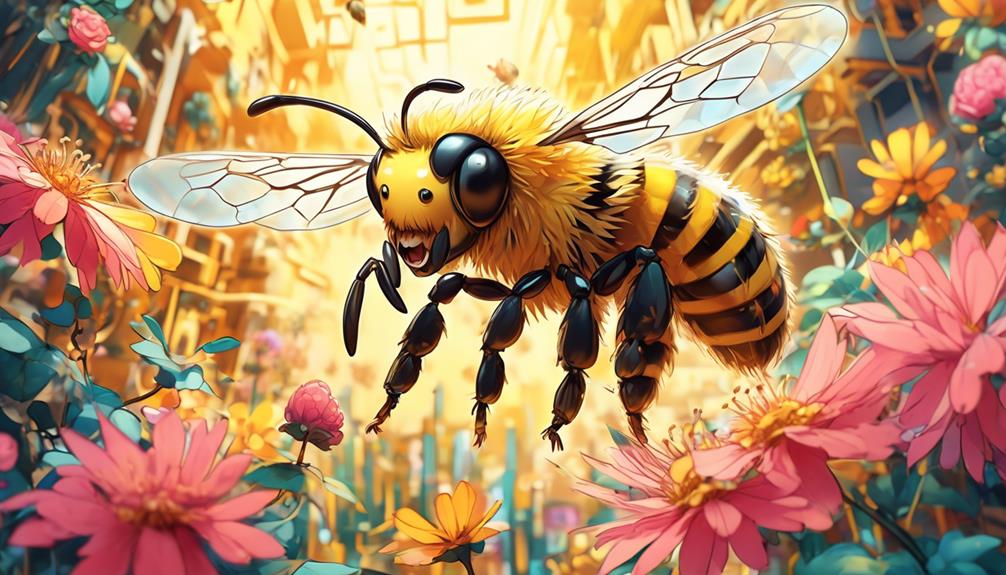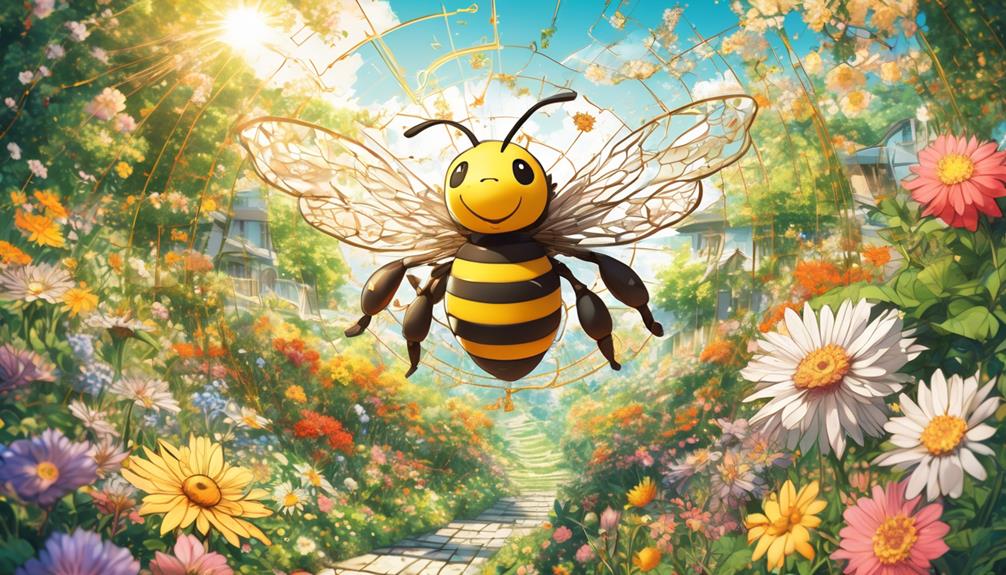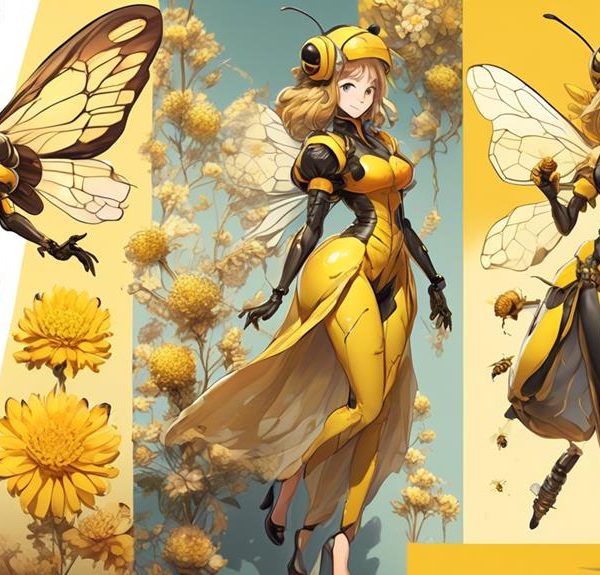Buzzing with surprising intelligence, bees exhibit complex problem-solving, communication, and navigation skills; discover the impact of these abilities on their survival and environment.

Are Bees Intelligent?
Can you imagine a creature smaller than your thumb being capable of complex problem-solving, communication, and even navigation? You're about to embark on a journey into the fascinating world of bee intelligence.
Bees, despite their minute size, exhibit astonishing cognitive abilities that rival many larger species. As you explore this topic, you'll delve into the intricacies of bee problem-solving, their unique methods of communication, their impressive navigation skills, and their ability to recognize various objects.
But, the question remains, what impact does this intelligence have on their survival and their interaction with the environment? Stay tuned as we uncover the remarkable intelligence of these tiny creatures.
Key Takeaways
- Bees exhibit complex problem-solving abilities and cognitive function that challenge traditional definitions of intelligence.
- Bees communicate through intricate methods such as the waggle dance, pheromones, and vibrational signals, showcasing their intelligence.
- Bees have exceptional navigation skills, using memorized landmarks, sun positioning, and possibly magnetic fields to chart their courses.
- Bees demonstrate impressive recognition abilities, recognizing patterns, shapes, colors, and even human faces, further highlighting their intelligence.
Understanding Bee Intelligence

When you delve into the world of bee intelligence, you'll find that these tiny creatures exhibit complex behaviors and problem-solving abilities that challenge our traditional definitions of intelligence. Their capacity for learning and remembering is astounding, especially considering their relatively small brain size.
Bees demonstrate advanced spatial awareness and memory abilities, efficiently navigating complex environments and returning home over miles of terrain. They're able to recognize patterns and colors, and can even be trained to associate specific patterns with rewards, demonstrating associative learning.
Not only can bees learn, but they can also teach. Through the 'waggle dance', a unique form of communication, they share the location of food sources with their hive mates. This sophisticated form of communication points to a degree of social intelligence.
Moreover, bees exhibit problem-solving skills. They're capable of pulling strings and rolling balls to obtain rewards, tasks that require an understanding of cause and effect.
Bees and Problem Solving

How do bees demonstrate their problem-solving abilities, you may wonder? Research has shown that these insect marvels utilize complex thought processes to overcome obstacles.
For instance, in a study by Queen Mary University of London, bees were trained to roll a ball to a specific location to receive a reward of sugar water. Not only did the bees quickly learn this task, they also improved upon it, choosing the shortest route to the goal. Astonishingly, they figured this out even when the ball was placed in a new location.
Furthermore, bees can make connections between visual cues and rewards, a skill known as associative learning. They've been observed changing their foraging strategies based on the color and shape of flowers, showing they can learn and adapt to new information.
In another experiment, bees were shown to understand the concept of 'zero', a cognitive ability previously thought to be exclusive to humans and some primates. This indicates that bees may possess a higher level of cognitive function than previously believed.
Communication Among Bees

In the bustling hive, intricate communication among bees is a fascinating display of their cognitive prowess. You'd be amazed at how bees use a series of movements, known as the waggle dance, to share the location of a food source with their hive mates. This isn't just random flapping about; it's a precise language of angles and durations.
In addition to their dance, bees communicate with pheromones, chemical signals that serve a variety of functions. Alarm pheromones, for instance, alert the hive to potential threats. Now, you might think that's all there is to it, but bees' communication methods are even more complex.
Communication Type | Function | Example |
|---|---|---|
Waggle Dance | Share location of resources | Angle and duration of dance indicate direction and distance |
Pheromones | Alert, attract, repel | Alarm pheromones alert the hive to danger |
Vibrational Signals | Activate certain behaviours | Worker bees signal the need for more foragers via vibrations |
As you delve deeper into the world of bees, you'll find that these little insects are more than just honey producers. Their communication skills are a testament to their intelligence, proving that size doesn't limit cognitive capabilities.
Navigation Skills of Bees

Moving from their remarkable communication methods, let's explore the bees' exceptional navigation skills which further showcase their intelligence. Bees are true navigational wizards, capable of traversing extensive distances to locate food sources and return to their hives accurately. They use a combination of memorized landmarks, sun positioning, and possibly even magnetic fields to chart their courses.
You might be surprised to learn that bees have a form of 'internal GPS'. They use the sun as a compass, adjusting their flight paths relative to the sun's movement across the sky. If you're wondering how they manage when it's cloudy, don't worry. Bees can detect polarized light patterns to determine the sun's position even on overcast days.
Furthermore, studies suggest that bees can memorize the landscape's features around their hive. They can remember these landmarks and use them to guide their return trips, even if they've been displaced several kilometers away.
Recognition Abilities in Bees

Diving deeper into the cognitive abilities of bees, you'll find their recognition skills particularly fascinating. These tiny insects display an uncanny ability to recognize patterns, shapes, and colors.
Consider their foraging behavior: bees don't randomly search for nectar. Instead, they've been observed to remember the locations of flowers, their shapes, and even the time of day these flowers produce the most nectar. They're capable of recognizing visual cues and integrating this information into their daily routines.
Moreover, it's not just floral patterns bees recognize. They've also demonstrated the ability to recognize human faces. In a series of experiments, bees were trained to associate pictures of human faces with sugary rewards. The bees remembered and returned to the images they associated with food, even after 24 hours. They were distinguishing between different faces, proving they can recognize and remember complex patterns.
These recognition abilities are more than just impressive; they're essential for the bees' survival. They allow bees to efficiently locate and return to food sources, a crucial skill in their fast-paced, resource-driven lives. This level of intelligence furthers our understanding of bees and their intricate world.
The Impact of Bee Intelligence

While the recognition abilities of bees are truly remarkable, they only scratch the surface of the broader implications of bee intelligence on the natural world and our understanding of it. You see, bees are crucial pollinators, and their intelligence plays a key role in this process. Through their complex communication patterns, they're able to locate and remember the locations of flowering plants which are vital for pollination.
In fact, bees' ability to learn and remember these locations, and communicate them to their hive, is an example of a cognitive process known as spatial memory. It's a form of intelligence that's essential for their survival and, by extension, ours. The decline of bees globally has serious implications for agriculture and biodiversity due to the loss of this pollination service.
Furthermore, the intelligence of bees challenges our understanding of intelligence itself. Their tiny brains, about the size of a sesame seed, are capable of complex tasks. This contradicts the common assumption that larger brains equate to greater intelligence. The study of bee cognition, therefore, could provide valuable insights into the nature of intelligence and cognition.
Frequently Asked Questions
How Does the Intelligence of Bees Compare to Other Insects?
You're wondering how bee intelligence stacks up against other insects.
Bees are remarkably intelligent, far surpassing many insect counterparts. With the ability to communicate via 'dances' to convey distance and direction of food sources, they've proven themselves capable of complex social interaction.
They're also known to recognize human faces and can learn and remember colors and patterns.
What Are the Threats to Bee Intelligence and How Can They Be Mitigated?
You're asking about threats to bee cognition and possible solutions.
Pesticides, particularly neonicotinoids, can greatly impair a bee's learning and memory.
Uncontrolled urbanization also disrupts their habitats.
Mitigation strategies include reducing pesticide use, creating bee-friendly habitats, and promoting biodiversity.
You can also support research into bee cognition to help develop further conservation strategies.
Essentially, it's about respecting and preserving their natural environment.
Can the Intelligence of Bees Be Enhanced or Developed Further?
Yes, you can enhance a bee's intelligence further. It's all about their environment. If you provide them with complex, stimulating conditions, they'll adapt and learn.
They're quick learners, especially when their survival depends on it. Experimentation with different teaching methods can also help. But remember, it's not about making them 'smarter,' but rather about improving their existing skills and abilities, like problem-solving and communication.
How Does the Intelligence of Bees Contribute to Their Survival and Propagation?
Bees' intelligence significantly boosts their survival and propagation. They use complex navigation methods, remember flower locations, and communicate through 'waggle dances'. This allows efficient food collection, minimizing energy wastage.
Their ability to remember dangerous situations aids in avoiding predators. Moreover, they can recognize human faces, which could have implications for their interactions with humans.
This intricate blend of abilities showcases how bees' intelligence crucially contributes to their survival and propagation.
Is There a Correlation Between the Size of a Bee and Its Intelligence?
You're wondering if there's a correlation between a bee's size and its intelligence.
It's not size that matters but the complexity of a bee's behavior and its ability to learn and remember.
Research shows that despite their small brain size, bees display a great ability to learn and adapt.
Conclusion
In conclusion, you'd be mistaken to underestimate bee intelligence. They're impressive problem solvers, remarkable communicators, and exceptional navigators.
Their recognition abilities are also worth noting. This intelligence not only has a profound impact on their survival but also on the overall environment, particularly in pollination.
So, it's crucial to respect and protect these tiny yet mighty creatures. Their intelligence is unquestionable and their role in our ecosystem, irreplaceable.


